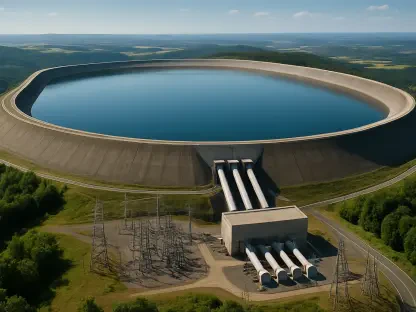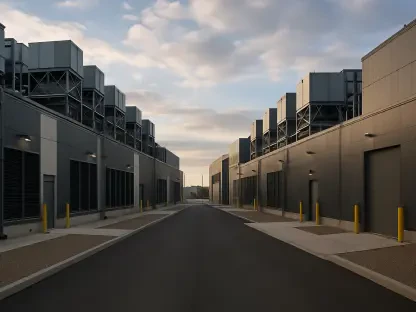With 80% of the buildings that will exist in 2050 already constructed, current structures play a massive role in meeting carbon reduction targets. Facility managers are pivotal in managing carbon during fit-outs and refurbishments. This responsibility is not just about compliance with regulations but also about unlocking significant environmental and financial benefits. Achieving a successful balance between energy efficiency, sustainability, and operational goals requires a strategic and systematic approach. By following a series of critical steps, facility managers can ensure that these endeavors meet stakeholder expectations and contribute positively to global net-zero goals.
1. Data Analysis for Informed Decisions
One of the primary reasons carbon reduction initiatives may fall short is reliance on theoretical models rather than actual performance data. Real-world data is the cornerstone of effective carbon management during fit-outs and refurbishments. A comprehensive data analysis should start with half-hourly electricity metering and detailed gas consumption information. This helps establish a genuine performance baseline. Additional assessments like thermographic surveys, which pinpoint heat loss areas, and air pressure tests to locate leaks, should also be conducted. Moreover, U-value assessments of building fabric provide insight into the insulative properties of materials used. Buildings change over time due to factors such as altered usage patterns, maintenance routines, and materials aging. Conducting a thorough real-world evaluation ensures that interventions are grounded in reality rather than assumptions, forming the foundation for effective strategies moving forward.
Armed with genuine performance data, facility managers can reconcile design expectations with actual building behavior. This iterative process helps bridge the gap between theoretical models and real-world function by continuously refining assumptions with updated data. Utilizing this knowledge, facility managers can work with engineers and architects to identify practical improvements. These might involve updating insulation materials, optimizing HVAC system settings, or reshaping usage patterns. By leveraging actual data, teams can focus on tangible changes that enhance energy efficiency and reduce carbon footprints, avoiding the pitfalls of carbon management based solely on theoretical designs.
2. Strategic Design Solutions
The design phase translates comprehensive data into actionable plans. It’s during this phase that facility managers integrate whole-life carbon assessments, considering both embodied carbon from construction materials and processes and operational energy usage. This holistic approach ensures carbon shifting, or the offsetting of low operational emissions with high-embodied carbon materials, is avoided. By partnering with architects knowledgeable about sustainability, projects can procure genuinely effective solutions rather than superficial measures. Whole-life assessments offer insights into the long-term sustainability of projects by balancing initial emissions with future energy efficiencies.
Integrating sustainability considerations early in the design process is integral to achieving real carbon reductions. A collaborative effort with sustainability-oriented architects and energy modelers helps align energy modeling with actual building performance. Stakeholder engagement becomes vital to ensure proposed designs align with regulatory requirements and occupant needs. Designers and architects should incorporate strategies such as passive solar design, natural ventilation, and effective use of daylighting. Platforms facilitating communication between the design team and stakeholders foster a shared vision. It is through these strategic collaborations that facility managers can spearhead fit-out projects that dramatically cut carbon emissions and optimize energy usage.
3. Investment and Financial Mechanisms
Investment in carbon reduction cannot be isolated from financial realities. Various financial mechanisms exist to support energy-efficient projects, especially in the public sector. Incentives such as the Public Sector Decarbonization Scheme and the Low Carbon Skills Fund offer substantial support for sustainable projects. These incentives assist in offsetting upfront costs, making ambitious projects financially viable for organizations of all sizes. Moreover, exploring innovative financial models like Recycling Funds—which are repaid through energy savings—can offer sustainable returns on investment while promoting carbon reduction.
Careful consideration of available financial support and incentives can significantly influence project feasibility. Facility managers should actively seek opportunities to leverage schemes and funds tailored to carbon reduction. Understanding funding structures and applying for pertinent programs becomes a key competency, opening new avenues for project planning. Aligning projects with eligible criteria for funding can reduce financial barriers, allowing for greater ambition in design and construction. Through strategic engagement with these financial mechanisms, facility managers can ensure that projects are both financially viable and aligned with overarching sustainability goals.
4. Installation through Real-World Challenges
Installation brings design concepts to fruition, turning plans into tangible improvements. This phase demands careful planning and coordination, especially in occupied buildings where ongoing activities and business functions must continue uninterrupted. Pre-work assessments, including building information surveys, aid in identifying and mitigating potential hazards like asbestos. Complex installation environments may need isolated work zones, advanced air quality management, and effective contamination prevention tactics. Thorough planning can streamline installation processes, ensuring continuity of vital services and minimizing disruptions. Collaboration with maintenance teams is crucial, as is adherence to safety and environmental standards.
Successful installations require proactive risk management, precision in execution, and cross-functional collaboration. For complex projects, facility managers should coordinate closely with diverse teams, including contractors, safety managers, and building operators. Proper communication channels help synchronize activities, manage schedules, mitigate risks, and maintain transparent information flows. The intricacies of installation in densely populated or sensitive environments do not just involve logistical challenges but demand a keen focus on health, safety, and environmental protocols. This approach assures that installations meet design expectations while upholding commitments to safety, maintaining business continuity, and adhering to ecological concerns.
5. Evaluation and Optimization for Continued Success
Finalizing installations marks the transition to post-occupancy evaluations, ensuring buildings deliver anticipated performance. Schemes like NABERS UK’s Design for Performance provide industry benchmarks, helping validate post-construction outcomes. Initial assessments should identify inefficiencies that could hinder performance expectations, such as simultaneous heating and cooling of spaces. Facility managers should address and rectify these through fine-tuning building control systems. Continuous monitoring systems offer insights into operations, facilitating proactive adjustments and anticipated performance shifts due to seasonal changes or evolving use patterns.
Ongoing evaluation and optimization is not merely a final step; it is a continual process of tuning operations for peak efficiency. Facility managers should engage in seasonal commissioning, adjusting systems for optimal performance in varying climate conditions, potentially reducing energy consumption by 10-15%. Early-stage identification of opportunities for simple, effective improvements can circumvent the need for expensive capital investments. By applying a strategic optimization approach, facility managers can perpetually enhance building performance, reinforce carbon reduction efforts, and sustainably achieve operational objectives over time.
Charting the Path Forward
With a substantial 80% of the buildings that will be standing in 2050 already built, their existing infrastructures are crucial in achieving carbon reduction targets. Facility managers hold an essential role in managing carbon footprints during building fit-outs and refurbishments. This duty extends beyond simply adhering to regulations; it also involves tapping into notable environmental and financial gains. To maintain a successful balance between energy efficiency, sustainability, and their operational objectives, facility managers need a strategic and systematic plan. By implementing a series of vital steps, they can ensure that these efforts align with stakeholder expectations and have a positive impact on the global drive towards net-zero emissions. Moreover, by promoting renewable energy sources, optimizing resource use, and reducing waste, managers can enhance building performance. These practices not only contribute to sustainability but can also lead to cost savings, thus promoting a culture of responsibility and innovation in the industry.









